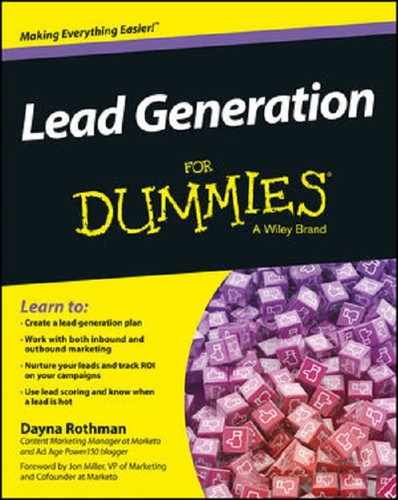Chapter 13
Targeting with a Personal Touch Through Direct Mail
In This Chapter
![]() Understanding how to include direct mail as part of the modern marketing mix
Understanding how to include direct mail as part of the modern marketing mix
![]() Designing your direct mail to drive leads farther down your funnel
Designing your direct mail to drive leads farther down your funnel
![]() Discovering the dos and don’ts of direct mail engagement
Discovering the dos and don’ts of direct mail engagement
![]() Combining your inbound, outbound, and direct mail efforts into an integrated campaign
Combining your inbound, outbound, and direct mail efforts into an integrated campaign
You're probably rolling your eyes at me and saying “Dayna, isn’t direct mail a thing of the past?” My answer is no, direct mail is actually still very relevant and effective. If you're curious about why I say that, read on.
The key to effective direct mail is approaching it in the right way and integrating it with other outbound and inbound lead-generation strategies to make it part of a full campaign.
In fact, direct mail can be highly personal and creative, depending on your mode of attack and how you target your list. If you don’t believe me, take a look at some of these convincing stats:
- Seventy-three percent of U.S. consumers said they prefer direct mail for brand communication because they can read information at their convenience. Source: Epsilon’s 2012 Channel Preference Study.
- Fifty-six percent of U.S. respondents agreed with the following statement: “I enjoy getting direct mail from brands about new products and services.” Source: Epsilon’s 2012 Channel Preference Study.
- Forty-eight percent of the U.K. population surveyed responded to a direct mail piece they received in the past year. Source: Central Mailing Services 2013 Direct Mail Statistics.
- Eighty percent of marketers forecasted investment in direct mail and 28 percent reported increases in their budget. Source: Target Marketing Magazine’s Media Usage Forecast 2013.
- U.S. advertisers spend $167 per person on direct mail to earn $2,095 worth of goods sold, which is a 1,300-percent return on investment. Source: Print Drives Commerce 2013.
Hopefully these stats convince you or at least open your mind to learning more about direct mail for lead generation. The key is to make sure your campaigns are targeted, creative, and integrated with the rest of your lead-generation strategies.
Making Direct Mail Work for You
Direct mail is a great opportunity to target a select group of leads in a creative and unique way. It also can get pretty expensive. I recommend that you not do large mass-mailings. They are impersonal and rarely creative. You don’t want your direct mail piece ending up straight in the garbage, so how can you ensure that your mailer is actually engaged with, and (no surprise) demonstrates a return on those marketing dollars? Read on to find out more.
Setting your objectives
As with everything lead-generation related, what are your goals and objectives for your program? Maybe it's moving a selection of hot prospects down your funnel, or maybe it is an exclusive event invitation. Direct mail is expensive, so make sure you know exactly what you want to get out of it. Here are some sample objectives that you might have for direct mail:
- Closing key target accounts
- Moving key target accounts down your sales funnel
- Accelerating lead movement towards the end of the month
- Demo requests
- Introducing new leads to your company
- Sending personalized invites to an event
- Cementing relationships with key influencers in a company
Sending general blanket mailers with no clear CTA or goal leads to lackluster reception and conversions. The more specific you can be with your goals, the more you can target and segment your audience and creative approach.
Defining your audience
The most important element of a direct mail campaign is ensuring your mail is highly targeted to the correct audience. Your direct mail piece should be personal and speak directly to your audience. For instance, if you are targeting a handful of important accounts to move them closer to being customers, you should personalize each direct mail piece to your list of decision-makers.
Even if you are sending a more generalized mailer to either a purchased list or your database, you should still be segmenting your list based on demographic or behavioral data.
Take a look at Figure 13-1 for an example of effective targeting. This is a direct mail piece sent out by a company called Hop and Peck in the U.K.. They make handcrafted wooden toys. They created a direct mail campaign to target moms. They used a highly personalized approach, down to the name of the recipient and their child’s birthday.

Figure 13-1: A targeted and personalized direct mail campaign.
What did they do right? So many things. They understood their audience, personalized each response, and created copy that spoke directly to the lead on an emotional level.
They could have sent out a general mailer that just contained information about the company. But that wouldn’t have garnered an emotional reaction from their audience in quite the same way.
Choosing your offer
You need a strong CTA in order for direct mail to work for you. What do you want a person to do upon receiving your mailer? Call for a demo? Go to a landing page to download a content asset or sign up for a webinar?
Direct mail CTAs are trickier than web CTAs because you have to entice a lead to stop what he is doing to call a number or go online. Here are some tips to make your CTA stand out with direct mail:
- Use strong language: You need to get your lead excited! Use strong, expressive language to incite an immediate response.
- Use a PURL (Personal URL) CTA: Include a PURL in your direct mail piece. People are often more incentivized to take an action if they see a personalized URL. Your PURL should then lead to a personalized landing page that speaks directly to your recipient.
- Don’t have too many CTAs: It is tempting to use as much real estate as possible to overload your mailer with CTAs. Too many CTAs are the kiss of death and a sure invitation to pitch your mailer into the garbage. If you have more than one CTA, create a hierarchy so your lead knows exactly what the most important element is.
- Speak directly to your lead: Use a recipient’s name in the CTA. If you are speaking to the lead directly, she is way more likely to act.
- Offer an incentive: Want the lead to sign up for a demo? Include an offer for a $50 Visa gift card. Your lead is way more likely to take action if there is a WIIFM (What’s In It For Me).
- Consider using a QR (Quick Response) code: Including a QR code is another quick and easy way for your lead to get to a landing page with an additional offer or CTA. All he does is snap a picture of the code and he can go to a dedicated landing page.
- Always have a landing page: No matter what your CTA is, always have a landing page created exclusively for your direct mail piece. The user experience should be seamless and consistent.
Figure 13-2 shows an example of a Pitney Bowes direct mailer that has many of these suggested CTA elements. The copy is personalized, uses strong language, has a PURL CTA that asks the recipient to visit a landing page, and offers an appealing incentive.
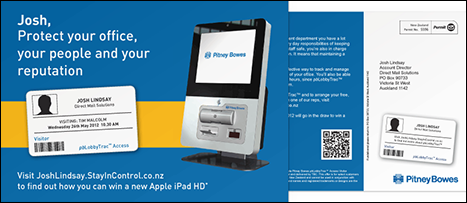
Figure 13-2: A Pitney Bowes direct mailer.
Syncing to your marketing automation
Many marketing automation tools have the ability to integrate with direct mail campaigns. This is an effective option to ensure an integrated campaign approach and proper follow-up for your program. For instance, many marketing automation platforms can send a trigger email when someone has signed for a direct mail piece, or when a recipient visits their PURL or scans a QR code. Additionally, a visit to a landing page can also trigger an increase in lead score.
Follow-up is a critical element, so by syncing a marketing automation platform to your campaign, you can ensure a timely follow-up to hundreds or thousands of leads and have insight into your lead’s actions.
Another way that you can include direct mail with your marketing automation is to trigger a direct mail piece to be sent out after your lead hits a certain score threshold, or if he has engaged with a particular email campaign.
Joining forces with marketing automation also enables you to track direct mail performance, which helps you track ROI. And for an expensive program like direct mail, knowing how leads interact with your campaign is a critical element.
Focusing on Creative Execution
The key to a successful direct mail campaign is creative execution: in other words, what your direct mailer looks like. I caution you against sending out a typical postcard. Think outside of the box for your direct mail pieces, have an eye-catching design and theme, and don’t be afraid to use some mixed media by sending out packages instead of postcards. And because you are hopefully sending out your direct mail pieces to a targeted list, you can get a bit more creative and have a bit of a higher budget to make your mail pieces really pop.
Choosing the right medium
Most marketers think of direct mail in terms of only a 4 x 6 postcard. And yes, this could work, but have you thought about all the other forms direct mail can take?
To illustrate my point, check out these truly creative and inventive non-postcard direct mailers. These pieces have a theme and are highly memorable to the leads who receive them.
Figure 13-3 shows an example of a Cox Business campaign sent from a sales rep when a new lead enters their system. This package includes a postcard with a three-dimensional hand that pops out and reads, “Nice to meet you.” The outside of the card has the name of the sales rep. Cox also includes a coffee cup that says, “Find out how we can perk up your business,” and a Starbucks Via coffee packet. Cox hits the nail on the head with this campaign. It not only has that personal feel but uses a different medium and includes a functional element — the cup and the coffee.
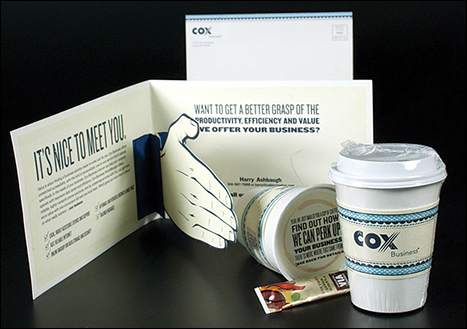
Figure 13-3: A Cox Business “Nice to Meet You” campaign.
Another great campaign is Infinity Direct’s marketing apothecary bag piece, shown in Figure 13-4. As a marketing agency, they needed something that appealed to marketers, so they took a creative approach by sending a 3D pop-out apothecary bag that included “marketing malady cures” such as “Functional Blog Balm” with directions like “Use for treatment of tight deadline syndrome.” They also included a PURL for a personalized landing page.

Figure 13-4: Infinity Direct’s marketing apothecary bag.
The campaign in Figure 13-5 was sent by advertising agency Publicis to clients to let them know that in lieu of a holiday gift, they had donated to a local food bank in their names. They sent each client a customized paper plate that included information about the donation. The interesting angle? The paper plate, of course!
Avoiding the junk mail look
It's important to avoid a junk mail look when working with direct mail. People hate junk mail, and there are a ton of vendors out there sending busy, overloaded junk mail pieces. And what happens to these gems? They end up in the garbage. So make sure that your mail piece doesn't look like junk mail — which is achieved by clever creative, good targeting, and strong, clear CTAs.
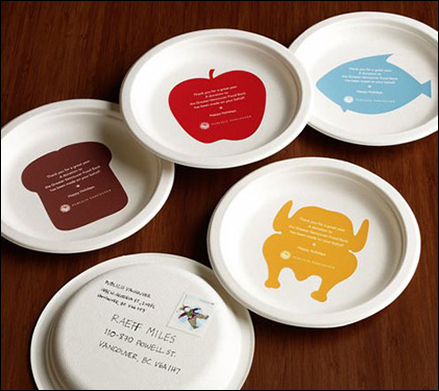
Figure 13-5: Publicis’s Paper Plate campaign.
What are some don’ts when it comes to direct mail? Here are two important concepts to keep in mind.
- Don’t use gimmicky language: Stay away from a ton of copy on your direct mail piece that says “Free,” “No Gimmick,” “Pre-Approved,” and so on. This type of language is a junk mail red flag.
- Stay away from a busy design: Marketers sometimes think the more they can jam on a direct mailer, the better, but in fact, the exact opposite is true. Your mailer should have a clean, streamlined look and be well-designed. A busy design looks like you threw it together in Microsoft Paint and printed it out yourself.
Figure 13-6 shows an example of two direct mail pieces that could easily be construed as junk mail. They break my two golden rules by using busy design and lots of gimmicky language.
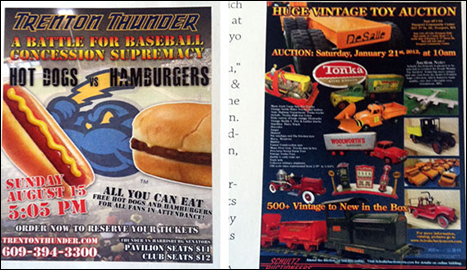
Figure 13-6: Junk mail examples.
Having an Integrated Approach
Your direct mail piece will be that much more effective if you combine with other channels by adding a PURL to a personalized landing page or website, sending out an email follow-up, or sending out a tweet to your lead. Because you can get creative with direct mail, it lends itself very well to a multichanneled approach for more of a campaign feel.
Another important element to an integrated direct mail campaign is appropriate follow-up through email, social channels, or ultimately a sales call, depending on lead’s actions. By ensuring you close the loop on your direct mail pieces, you can have a much higher ROI.
